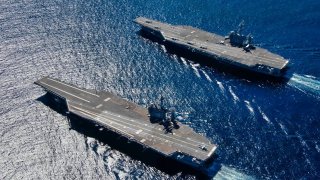Brandon J. Weichert

So, just how many aircraft carriers does the Indian Navy really need? It’s a trick question. India already has too many aircraft carriers as it is.
What India needs are countermeasures to overcome China’s anti-access/area denial (A2/AD) threat in the Indian Ocean. No one is really talking about this in defense systems. Everything remains fixated on making every allied military, whether it be Ukraine, Taiwan, or even India, into a miniature version of the US military, replete with legacy systems that are as suited for modern combat as the musket would be.
The aircraft carrier is increasingly obsolete in the age of advanced anti-access/area denial (A2/AD). Despite this fact, both India and China are racing each other to see which side can build the greatest number of aircraft carriers in the shortest amount of time. China has three functioning flat tops of varying degrees of sophistication, with a fourth, nuclear powered carrier in the pipeline.
India, meanwhile, has two carriers, with a third on the way. What the Indians fail to recognize is that China has an ace-in-the-hole that India otherwise lacks: Chinese A2/AD emplacements in the South China Sea can reachinto the Indian Ocean.
China’s A2/AD Threat Will Not Be Overcome with Aircraft Carriers
According to an analysis from the Institute of Peace and Conflict Studies (IPCS), China’s sophisticated arsenal of A2/AD throughout the South China Sea (SCS) not only covers the SCS but can strike at targets as far afield as the Bay of Bengal.
So, what is the point of India spending all this money to build aircraft carriers that will take years to learn how to operate properly, just to have China knock these systems out in the opening bid of any conflict with India?
India should be countering the rising Chinese A2/AD threat with their own versions of these systems. The Indian military should also look to further complicate China’s bid to become the dominant power not only in the Pacific, but the Indian Ocean, by expanding their already impressive presence in Ladakh, where Indian and Chinese have already clashed four years ago (and where armed conflict again could erupt at any moment).
Besides, China has already placed sophisticated surface-to-air (SAM) systems in both Xinjiang and Tibet while providing banned technology to Pakistan to upgrade its Integrated Air Defense System (IADS), according to a 2020 report by Brigadier Anil Gupta, an Indian military leader.
Submarines are a Better Investment
A better investment for India would be to both build out their own A2/AD network to similarly threaten Chinese surface ships and their warplanes, should conflict between India and China erupt. Beyond that, though, India needs a larger submarine fleet. It would be great if India were let into the Australia-United Kingdom-United States (AUKUS) nuclear submarine building alliance.
Although, Indian officials have expressed a desire to work with France, which is still smarting over their loss of the submarine contract with Australia to the United States and Britain, on building submarines. This desire by India is in keeping with their long-running belief that they should never rely on any single foreign power—especially Wester powers—for their security. This is born out of their colonial history with Britain, which they view as a generally negative experience.
Whether it be AUKUS or France, though, India must move with great alacrity in developing and deploying a much larger, modern submarine force to counter China’s navy in the Indian Ocean.
Other Complex Systems Needed
Further, India must invest more into building their own arsenal of complex unmanned underwater vehicles (UUV) and unmanned aerial drones (UAV). At the same time, India must increase funding for their hypersonic weapons capability as well as directed energy weapons (DEW).
Another area of importance is space. India has become one of a handful of nations to successfully test counterspace capabilities—an anti-satellite (ASAT) weapon—as a demonstration of power to China. It should expand these capabilities to better threaten China’s growing suite of satellite capabilities.
Not another rupee should be spent on building aircraft carriers. At least not until the Chinese A2/AD threat is overcome. The systems discussed here will all be far more beneficial—and affordable—to the Indian military than any flat top ever could be.
No comments:
Post a Comment